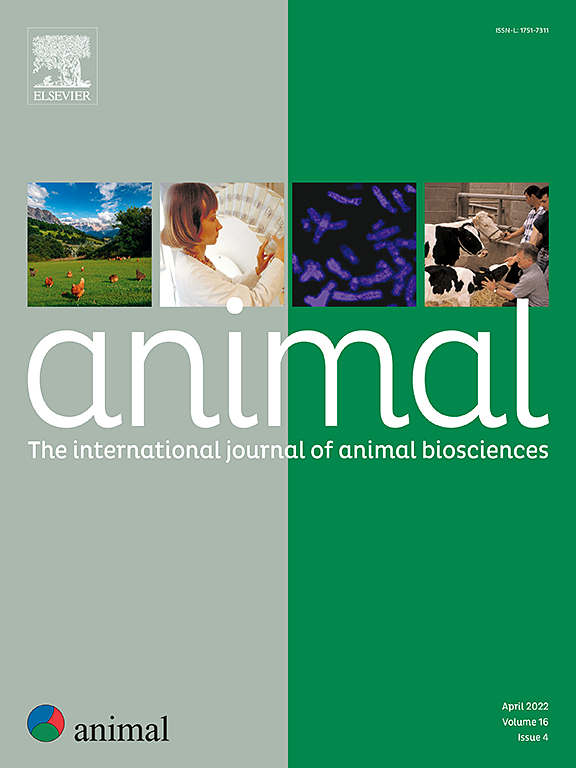Comparative intake, digestibility and enteric methane emissions by growing lambs and goat kids fed a medium digestibility grass nuts diet
IF 4
2区 农林科学
Q1 AGRICULTURE, DAIRY & ANIMAL SCIENCE
引用次数: 0
Abstract
The availability of baseline emission data across various livestock systems is an essential component of identifying suitable mitigation strategies for the future. However, the comparative CH4 emissions of different livestock species, particularly those that represent key small ruminants globally (sheep (Ovis aries) and goats (Capra hircus)), have not been explored in the context of diet digestibility and growth potential of the animal. This study aimed to generate baseline data through comparing weaned lambs and goat kids in relation to (1) growth performance, (2) enteric methane emissions, (3) and diet in vivo digestibility of a common medium-digestibility diet that reflects the pasture type that the animals might be expected to graze. Ten castrated lambs (Welsh Mountain breed) and ten goat kids (Cashmere × Boer crossbreed) of an equivalent age postweaning (c. 12 months) (avg. starting weight of 15 kg ± 0.86, and 26 kg ± 1.02, respectively) were offered a grass-nuts diet ad libitum whilst housed in individual pens. Dry matter intake (DMI) of feed was monitored daily throughout an 8-week growth stage, whilst liveweight was assessed weekly. Enteric CH4 emissions of each animal were recorded for 72 h in methane collection chambers. We found significantly higher liveweight gains for the sheep compared to goats (163 and 84 g/day for lambs and kids respectively; SED = 12.8; P < 0.001), as well as higher DMI (1299.8 vs 881.8 g/day; SED = 64.7; P < 0.001). DM intake was comparable between species on a metabolic liveweight (W0.75) basis. The sheep also produced higher daily CH4 emissions (26.3 g/day, and 19.4 g/day, respectively; SED = 3.02; P < 0.01) than goats. However, no effect of species was observed on CH4 emissions per kg W0.75 or per kg DMI. The proportion of methane energy excreted expressed as a proportion of diet gross energy (Ym) was similar for both species (4.9 and 4.6% CH4 E/gross energy intake for lambs and kids, respectively; SED = 0.46), as were apparent whole-tract in vivo DM digestibility, although the sheep had a better feed conversion ratio (FCR) than the goats (6.6 g DMI/ g W0.75 gain and 11.5 g DMI/g W0.75 gain, respectively; SED = 1.58; P < 0.05). Here, we found that sheep were more efficient than goats when offered an identical diet of grass nuts, giving a higher weight gain than the goats (resulting in a lower FCR), whilst also producing similar CH4 emissions to the goats on a metabolic LW basis.
饲喂中等消化率草果饲粮的生长羔羊和山羊幼崽的比较摄食量、消化率和肠道甲烷排放
获得各种牲畜系统的基线排放数据是确定未来适当的减缓战略的一个重要组成部分。然而,不同家畜物种,特别是全球主要小型反刍动物(绵羊(Ovis aries)和山羊(Capra hircus))的甲烷排放量的比较,尚未在动物的日粮消化率和生长潜力的背景下进行探讨。本研究旨在通过比较断奶羔羊和山羊在以下方面的基线数据:(1)生长性能,(2)肠道甲烷排放,(3)中等消化率日粮的体内消化率,该日粮反映了动物可能会放牧的牧场类型。断奶后同等年龄(约12个月)(平均起始体重分别为15 kg±0.86和26 kg±1.02)的10只阉割羔羊(威尔士山地品种)和10只山羊(喀什米尔与波尔杂交品种)在单独围栏内随意饲喂草坚果饲粮。在8周的生长期内,每天监测饲料干物质采食量(DMI),每周评估活重。在甲烷收集室中记录每只动物72 h的肠道CH4排放量。我们发现,与山羊相比,绵羊的活重增加明显更高(羔羊和幼畜分别为163克和84克/天);sed = 12.8;P & lt;0.001),以及更高的DMI (1299.8 vs 881.8 g/天;Sed = 64.7;P & lt;0.001)。在代谢活重(W0.75)的基础上,不同物种之间的DM摄入量具有可比性。绵羊日CH4排放量也较高,分别为26.3 g/d和19.4 g/d;Sed = 3.02;P & lt;比山羊高0.01)。然而,没有观察到物种对每kg W0.75或每kg DMI的CH4排放量的影响。两种动物的甲烷能排泄量占饲粮总能的比例(Ym)相似,羔羊和幼畜的CH4 E/总能的比例分别为4.9和4.6%;绵羊的饲料系数(FCR)高于山羊(分别为6.6 g DMI/g W0.75增重和11.5 g DMI/g W0.75增重);Sed = 1.58;P & lt;0.05)。在这里,我们发现,当提供相同的草果饲料时,绵羊比山羊效率更高,体重增加比山羊高(导致更低的FCR),同时在代谢LW的基础上也产生与山羊相似的CH4排放。
本文章由计算机程序翻译,如有差异,请以英文原文为准。
求助全文
约1分钟内获得全文
求助全文
来源期刊

Animal
农林科学-奶制品与动物科学
CiteScore
7.50
自引率
2.80%
发文量
246
审稿时长
3 months
期刊介绍:
Editorial board
animal attracts the best research in animal biology and animal systems from across the spectrum of the agricultural, biomedical, and environmental sciences. It is the central element in an exciting collaboration between the British Society of Animal Science (BSAS), Institut National de la Recherche Agronomique (INRA) and the European Federation of Animal Science (EAAP) and represents a merging of three scientific journals: Animal Science; Animal Research; Reproduction, Nutrition, Development. animal publishes original cutting-edge research, ''hot'' topics and horizon-scanning reviews on animal-related aspects of the life sciences at the molecular, cellular, organ, whole animal and production system levels. The main subject areas include: breeding and genetics; nutrition; physiology and functional biology of systems; behaviour, health and welfare; farming systems, environmental impact and climate change; product quality, human health and well-being. Animal models and papers dealing with the integration of research between these topics and their impact on the environment and people are particularly welcome.
 求助内容:
求助内容: 应助结果提醒方式:
应助结果提醒方式:


